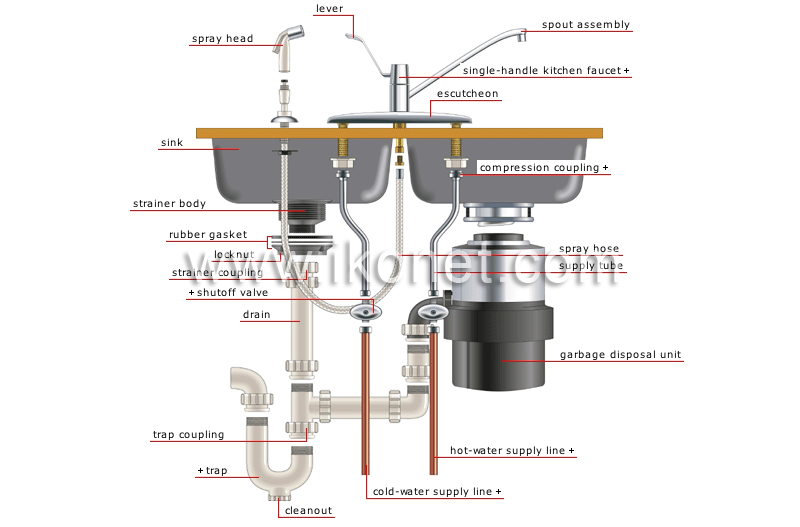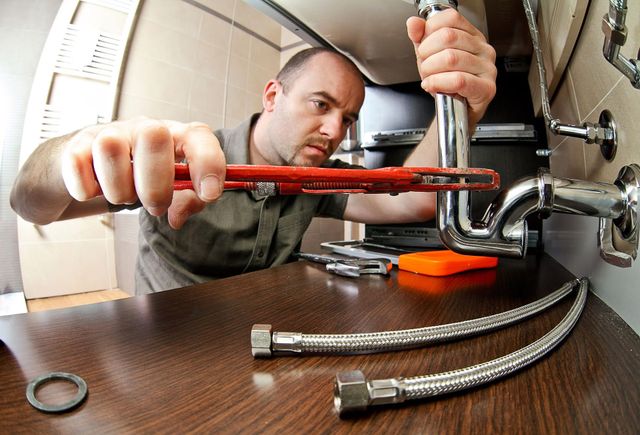A Guide to Your House's Plumbing System Anatomy
A Guide to Your House's Plumbing System Anatomy
Blog Article
We have noticed the article about The Inner Workings of Your Home's Plumbing listed below on the web and believe it made good sense to discuss it with you on this page.

Understanding how your home's plumbing system works is vital for every single property owner. From delivering clean water for drinking, cooking, and bathing to safely removing wastewater, a well-kept pipes system is vital for your family members's wellness and comfort. In this comprehensive guide, we'll explore the elaborate network that comprises your home's plumbing and offer suggestions on maintenance, upgrades, and handling usual concerns.
Intro
Your home's plumbing system is more than just a network of pipes; it's a complex system that ensures you have access to tidy water and reliable wastewater elimination. Recognizing its parts and just how they collaborate can assist you stop expensive repair services and make sure everything runs smoothly.
Fundamental Parts of a Plumbing System
Pipes and Tubes
At the heart of your plumbing system are the pipes and tubes that lug water throughout your home. These can be constructed from different materials such as copper, PVC, or PEX, each with its advantages in terms of sturdiness and cost-effectiveness.
Fixtures: Sinks, Toilets, Showers, and so on.
Components like sinks, commodes, showers, and bath tubs are where water is utilized in your home. Comprehending just how these components connect to the plumbing system aids in identifying problems and intending upgrades.
Valves and Shut-off Points
Shutoffs manage the flow of water in your plumbing system. Shut-off valves are essential throughout emergency situations or when you need to make fixings, enabling you to isolate parts of the system without interfering with water flow to the entire residence.
Water System System
Main Water Line
The major water line links your home to the metropolitan water system or a personal well. It's where water enters your home and is dispersed to different components.
Water Meter and Pressure Regulator
The water meter actions your water use, while a pressure regulatory authority ensures that water streams at a safe stress throughout your home's plumbing system, protecting against damage to pipelines and fixtures.
Cold Water vs. Warm water Lines
Comprehending the distinction between cold water lines, which provide water directly from the major, and hot water lines, which carry heated water from the hot water heater, helps in repairing and planning for upgrades.
Water drainage System
Drain Piping and Traps
Drain pipes carry wastewater far from sinks, showers, and toilets to the drain or septic tank. Traps stop sewer gases from entering your home and likewise trap debris that can trigger clogs.
Air flow Pipes
Ventilation pipelines enable air into the drain system, preventing suction that can slow water drainage and create traps to vacant. Proper air flow is important for keeping the integrity of your pipes system.
Importance of Appropriate Water Drainage
Guaranteeing correct water drainage protects against backups and water damage. Regularly cleaning up drains pipes and keeping traps can stop pricey repair work and prolong the life of your pipes system.
Water Heating Unit
Kinds Of Water Heaters
Hot water heater can be tankless or typical tank-style. Tankless heaters warmth water on demand, while containers store heated water for instant usage.
Updating Your Pipes System
Factors for Upgrading
Upgrading to water-efficient components or changing old pipes can improve water high quality, reduce water expenses, and raise the value of your home.
Modern Pipes Technologies and Their Advantages
Discover technologies like wise leak detectors, water-saving bathrooms, and energy-efficient water heaters that can save money and decrease ecological influence.
Price Factors To Consider and ROI
Compute the ahead of time prices versus long-term cost savings when taking into consideration plumbing upgrades. Numerous upgrades spend for themselves via minimized utility expenses and less repair services.
Exactly How Water Heaters Attach to the Pipes System
Recognizing just how hot water heater link to both the cold water supply and warm water circulation lines assists in detecting concerns like not enough warm water or leakages.
Upkeep Tips for Water Heaters
Routinely flushing your water heater to remove debris, examining the temperature level setups, and examining for leaks can extend its life-span and enhance energy efficiency.
Common Plumbing Issues
Leaks and Their Reasons
Leaks can happen due to maturing pipelines, loose fittings, or high water pressure. Dealing with leakages without delay protects against water damages and mold development.
Obstructions and Obstructions
Clogs in drains and bathrooms are typically caused by flushing non-flushable things or a build-up of oil and hair. Utilizing drain displays and bearing in mind what decreases your drains pipes can stop blockages.
Indicators of Plumbing Problems to Watch For
Low tide pressure, sluggish drains, foul odors, or unusually high water costs are indications of prospective plumbing troubles that must be dealt with without delay.
Plumbing Upkeep Tips
Regular Inspections and Checks
Set up annual pipes assessments to catch concerns early. Look for indicators of leaks, corrosion, or mineral build-up in faucets and showerheads.
DIY Maintenance Tasks
Straightforward tasks like cleansing faucet aerators, checking for commode leaks making use of dye tablets, or shielding subjected pipelines in cold environments can prevent major plumbing concerns.
When to Call a Professional Plumbing Technician
Know when a pipes issue requires expert knowledge. Attempting complicated repairs without proper understanding can lead to even more damage and greater repair expenses.
Tips for Minimizing Water Usage
Easy routines like fixing leaks quickly, taking much shorter showers, and running complete loads of laundry and meals can preserve water and lower your utility expenses.
Eco-Friendly Pipes Options
Consider lasting plumbing products like bamboo for floor covering, which is durable and eco-friendly, or recycled glass for counter tops.
Emergency situation Readiness
Actions to Take Throughout a Plumbing Emergency situation
Know where your shut-off shutoffs are located and how to shut off the water in case of a ruptured pipe or major leakage.
Significance of Having Emergency Situation Calls Convenient
Maintain contact information for regional plumbing technicians or emergency services easily available for quick action throughout a pipes situation.
Ecological Influence and Preservation
Water-Saving Fixtures and Home Appliances
Setting up low-flow taps, showerheads, and bathrooms can substantially lower water use without compromising efficiency.
Do It Yourself Emergency Situation Fixes (When Applicable).
Temporary fixes like using duct tape to patch a leaking pipeline or putting a container under a dripping faucet can minimize damage till a specialist plumber arrives.
Verdict.
Recognizing the makeup of your home's pipes system equips you to preserve it successfully, saving time and money on repairs. By complying with routine maintenance routines and staying notified regarding modern-day plumbing innovations, you can ensure your plumbing system runs efficiently for years to come.
Exploring Your Homes Plumbing Anatomy
Water Supply System
Main Water Line: This is where water enters your home from the municipal supply or a private well. Water Meter: Typically located near where the main water line enters the property, it measures the amount of water used. Shutoff Valve: It s crucial to know where this is in case of emergencies. It allows you to turn off the water supply to the entire house. Pipes and Fittings: These distribute water throughout your home. Materials can include copper, PVC, or PEX. Drain-Waste-Vent (DWV) System
Drains: Located in sinks, showers, and tubs, these carry wastewater away. Traps: U-shaped pipes under sinks that hold standing water, blocking sewer gases from entering the home. Vents: Pipes that lead from the DWV system to the outside, preventing vacuum formation and allowing gases to escape. Sewer Line: Carries all wastewater from the home to the municipal sewer system or a septic tank. Fixtures and Appliances
Sinks, Toilets, and Showers Dishwashers and Washing Machines Water Heaters Maintenance Tips
Regularly check for leaks in exposed pipes and around fixtures. Inspect the water heater annually for signs of wear. Clean drains and traps to prevent clogs and odors. Know how to shut off water to individual fixtures. When to Call a Professional
Major leaks or burst pipes Installation of new pipes or fixtures Septic tank issues Remodeling projects that involve plumbing changes Conclusion
Understanding the anatomy of your home's plumbing is key to maintaining a functional and efficient system. Regular checks and knowing when to call in the experts can save you time, money, and stress.
https://www.mavyn.com/blog/exploring-your-homes-plumbing-anatomy

Do you appreciate reading up on Exploring Your Homes Plumbing Anatomy? Place a remark directly below. We would be pleased to find out your views about this post. We hope that you visit us again soon. Sharing is nice. Helping others is fun. We love your readership.
Click Here Report this page